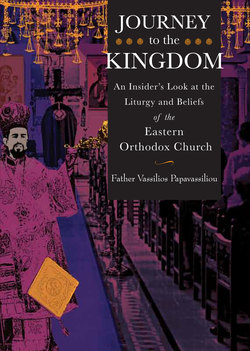Читать книгу Journey to the Kingdom - Fr. Vassilios Papavassiliou - Страница 7
ОглавлениеCome In And See
Come, I will show you the bride, the wife of the Lamb.
—REV. 21:9, NRIV
This is your invitation to come in and see how Orthodox Christians all over the world worship. Perhaps you have heard something about what we call the Divine Liturgy, the beauty of its expressions, the profundity with which this special service offers its participants a way to encounter God? If so, this book will take your understanding to the next level.
How better to get to know a faith than by experiencing, albeit secondhand, its primary form of worship? The sights and the symbols. The words of faith and the mysteries that are plumbed. Through twenty brief chapters, and just as many black-and-white photographs, you will learn much more.
In many ways, this book could be regarded as a form of liturgical catechism, or instruction about worship, for any and all interested in joining the Orthodox Church. But it is also more than that, as I hope that anyone—whether Orthodox already, considering joining an Orthodox church, or the simply curious—will find this tour of our liturgy and worship helpful and inspiring.
The “standard” Liturgy in all Eastern Orthodox Churches is that of St. John Chrysostom (ca. 347–407, archbishop of Constantinople). The Liturgy of St. Basil the Great (ca. 330–379, archbishop of Caesarea) is celebrated usually ten times a year: on the five Sundays of Great Lent, Christmas Eve, the Eve of Theophany, Great Thursday, Great Saturday, and on his feast day (January 1). Many of the prayers of the clergy in St. Basil’s Liturgy are different and considerably longer than those of St. John’s Liturgy.
On the weekdays of Great Lent (the forty-day period before Holy Week; Holy Week is when we celebrate the Passion and Resurrection of Christ), normal liturgies are not celebrated, except on the great feast of the Annunciation (March 25). Because liturgies are always a celebration, they are deemed inappropriate in Lent except on days on which we celebrate the Resurrection (Saturdays and Sundays) or a great feast like the Annunciation. In order that Christians may receive Communion more frequently during the period of Lent, we have the Liturgy of the Presanctified Gifts on Wednesdays and Fridays. This is a more somber service than other liturgies. It is called the Liturgy of the Presanctified Gifts because there is no consecration of the bread and wine. Instead, a portion of the Eucharist from the Sunday Liturgy is kept aside for these weekday services. Hence the term Presanctified Gifts, meaning that the holy gifts—that is, the bread and wine of the Eucharist—are from the very beginning of the service the Body and Blood of Christ, having been sanctified already at a previous Liturgy.
Journey to the Kingdom is not a work of scholarship. It is not a formal study of worship or liturgical history, nor is it a comprehensive commentary on the Divine Liturgy of the Orthodox Church. The purpose of this book is to explain the meaning of our worship, what happens at the service of the Divine Liturgy throughout the world, and the part that every Orthodox Christian plays in it.
By “Eastern Orthodox Church” we mean the family of Christian churches that traces its origins to Jesus Christ, acknowledges the authority of seven Ecumenical Councils, and is in communion with the ancient patriarchates of Constantinople, Alexandria, Antioch, and Jerusalem. These churches are defined by a strong sense not of being a denomination but of the continuing Christian Church that emerged in Jerusalem some two thousand years ago, as well as their adherence—despite their varied origins, liturgical practices, and customs—to what we refer to as the Byzantine rite.
When Vladimir the Great (958–1015) sent envoys around the world to study different religions so that he could decide which one to embrace, they did not inquire about doctrines or moral rules. Instead they watched those various religions at prayer, and it was the Divine Liturgy that they attended at the Church of Hagia Sophia in Constantinople that won them over. The best introduction to Orthodox Christianity is its primary act of worship. Of course, this book is no substitute for the real thing—it serves only as a guide and informant to enrich and shed light on that experience. But the Liturgy is not just prayer and song—it is rich with theology. What follows, therefore, is not only a guide to the Liturgy but also an introduction to Orthodoxy through the Liturgy.
